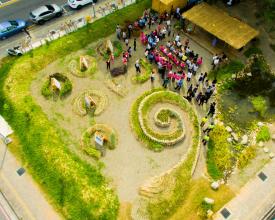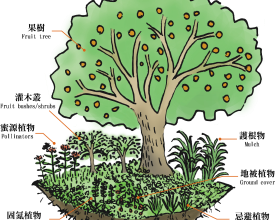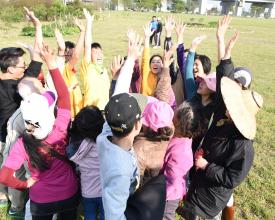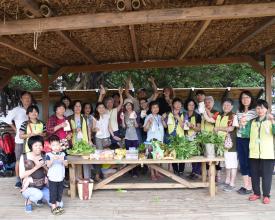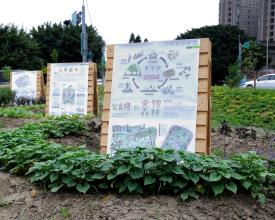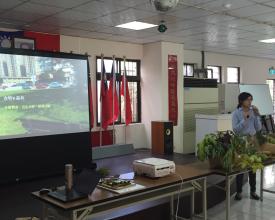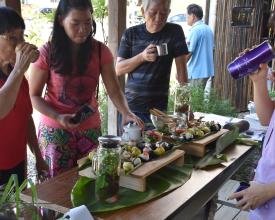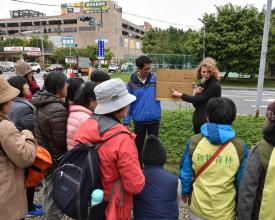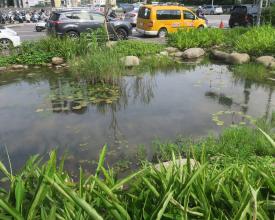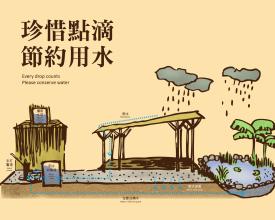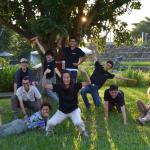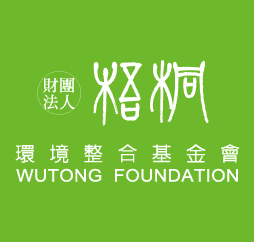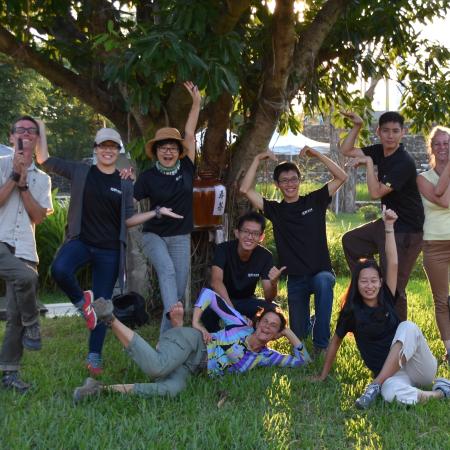
Urban Food Forest

More than half of the world population live in cities, and this number is expected to increase. Cities raise many environmental and social issues such as poor biodiversity, urban heat island effect, lack of resilience, food insecurity and many more. Our integrative solution is to build food forests in cities. A food forest is a sustainable design which mimics the ecosystem of a natural forest, with food production in mind. It started in Seattle, U.S. where people came up with the idea to build a food forest on a public lawn. We introduced the concept into Taiwan and built the first public food forest in Hsinchu where a partnership was created with the local government and community. Work parties and educational events are held to engage people in holistic learning and to share the harvest with all, including nature. Our solution has provided affordable healthy food for the community and demonstrates an ecosystem-based adaptation that can care for people and land at the same time.
Context
Challenges addressed
Food forest is a design that is derived from permaculture, which has three ethical basis: care for the earth, care for people, and fair share. Each of the ethical basis addresses environmental, social and economic challenges, respectively. UN research states that concentration of urban populations increases pollution, concentrates heat which influences weather patterns, and many other problems. Thus, our solution copes with the challenges caused by urbanization, including but not limited to 1) environmental: habitat and native species loss, unstable weather patterns, soil degradation and water runoff; 2) social: individual segregation, loss of sense of belongingness, generation gap, food insecurity, imbalanced education, and the decline of human physical and mental health conditions; 3) economic: high reliance on imports and exports, loss of available farmland, overconsumption and waste due to linear economy and the concept of private property.
Location
Process
Summary of the process
The three building blocks: an open and participatory process, educational opportunities and resiliency all contribute towards a sustainable food production system. At the same time, this also alleviates existing urban problems such as urban heat island effect, food insecurity, imbalanced education and many others. While resiliency ensures that you have a food forest that enhances biodiversity and minimizes maintenance energy and resources, an open and participatory process ensures that a public food forest meets the needs of most people, if not all, and therefore promises actual support from the stakeholders. It would be helpful to implement an open and participatory process from the very start so that not only you will get support and objective suggestions from the stakeholders, but also potential long-term participants. People are more likely to agree with and participate in projects that they have played a deciding role in. While the above two building blocks allow you to take the right path from the start, providing educational opportunities (the 3rd building block) will ensure long-term, continuous participation for the project, contributing towards a sustainable food forest.
Building Blocks
An Open and Participatory Process
Hsinchu Food Forest is a result of an open and participatory process between the municipality and several stakeholders of the city, like local residents, community groups, city agencies, schools, and even those that might not initially like the idea of an urban food forest. In order to assure public participation and support, it is essential to make every step of building the food forest an open and participatory process. We held over 30 hours of talks to educate local and surrounding communities the idea of a food forest, we even invited the co-founders of the Beacon Food Forest to share their experience with the municipal government and communities, which was a big help in getting the official to say yes. We also held a competition to collect people’s idea on the design of the site, and later asked a landscape designer to combine the ideas of the winning groups. We kept a close relationship with the managing official and local communities (and media) to make sure that the stakeholders would be informed of the latest progress of the food forest, and to modify the design in a timely manner when someone came up with concerns that had been neglected, such as people might trip and fall into the pond at night. We added a short hedgerow and lighting to prevent such possibilities.
Enabling factors
1. A group with strong incentives to carry out the project that can negotiate with different stakeholders and take the responsibility.
2. An open and positive attitude when facing obstacles and different opinions.
3. Full and clear understanding of the project, potential obstacles and other information by every stakeholder.
4. Support from every stakeholder/community member. This is critical when the project is on public land.
5. Participatory design: the community must be also consulted and engaged in the design of the site.
Lesson learned
The support of the landowner, especially when it is the municipal government, is very important in making this project is sustainable, as it helps face many challenges and bring legitimacy to the project. During the process, one will definitely face different opinions or stumble upon behavioral problems, sometimes reasonable and sometimes not. For example, many of the suggestions brought out by the local elders were against the “care for the earth” or “fair share” concept, such as wanting to use pesticides to alleviate pest problems, or keeping people they don’t like from participating in the food forest. While keeping an open and positive attitude and trying to make everyone equal and happy, we found it hard to enforce the code of conduct as we are not officials nor local residents. This is when the municipal government could play their part in coordinating conflicts and making the final judgment. Note that this might not be the case if the project is happening in other cultural settings.
Educational opportunities
Community engagement is very important in order to gather leverage support, grant funding, and general involvement. To ensure continuous involvement of the community/volunteer, providing educational opportunities for personal development is crucial. In our solution, these opportunities include attending educational workshops or work parties at the food forests, taking leadership at a work party, joining the core team to learn and participate in food forest development, planning educational or fundraising events...etc.
Technical knowledge and skills are offered through monthly work parties. People may learn new skills by doing hands-on work, and exchange problems/challenges that they face when implementing skills at home. Some topics we've held include making compost, bee hotels, turning garbage into enzymes, make-your-own toothpaste, and much more.
Providing educational opportunities can also help getting involvement from schools and universities. We receive many inquiries from schools for site visits. Teachers and students would come and learn about trends and social activities in the real world and can benefit from the holistic way of learning by balancing the use of head, hand, and heart when working in the food forests.
Enabling factors
1. Create fun and knowledgeable workshops/events that incorporate hands-on activities and reflection.
2. Patience and respect for individual differences: there is no definite answer in a food forest and every person learns and does work differently. Patience and respect are crucial to facilitate a successful educational event.
3. Pro-active outreach can help get the event word out and attract many more participants and even potential educators.
Lesson learned
It should be a high priority to establish larger groups that are committed to the project, in order to prevent the project from falling into disarray if the core people are no longer able to participate. Our primary participants are the elderly living next to the site. While they are devoted to taking care of the site, they may not be able to take the lead in organizing educational events or outreach. So we decided to reach out to local schools and organized tree-planting activities in order to attract new volunteers of new ages. The teachers were very happy about these educational opportunities, and the children and their parents continued to visit their trees after the event.
Educational events should be fun and applicable in the participants' daily life. At the same time, creating a fun and enjoyable learning group can be as important as coming up with an attractive topic.
Resiliency
An urban food forest symbolizes the city's ability to be resilient regarding climate change and food security issues. Thus, this system must manifest resiliency in itself, with a minimal vulnerability (to diseases, environmental or governance issues) and a maximal autonomy (energy, nutrients, water resources).
The urban food forest relies little on external resources for water and nutrients. Rainwater is collected through a rainwater collection system and then reused to refill the pond, clean the tools, and water the plants. Deadwood, leaves, fruit peelings, or weeds are composted in several compost bins. They will be transformed into very good quality compost and be reused in the forest garden to provide the plants with all the nutrients they need.
The food forest is made up of "tree guilds" which includes several layers of vegetation who mutually collaborate and help each other to grow faster and healthier. For example, there will be nectar plants to attract pollinators, associated with nitrogen-fixing plants, ground-cover plants to protect from weeds. Therefore, the urban food forest is resilient to environmental fluctuations and needs minimal human energy to be maintained.
Enabling factors
1. Water autonomy thanks to a rainwater collection system.
2. Nutrient autonomy and no waste generated thanks to the compost bins.
3. Make the plants collaborate and help each other through companion planting and tree guilds.
Lesson learned
At first, the communities had no idea about how the compost is working or what is companion-planting. That's why we organized "work parties" : to teach them how it works, how to do it and what are the basic principles of natural farming. Now, they are all able to maintain the compost by themselves, choose a good combination of plants, and last but not least, they can, in turn, teach these good practices to visitors or media.
A food forest takes time to mature before it can become fully resilient. At the moment, we still rely partially on the municipal water system in both Seattle and Hsinchu because of the insufficiency of rainwater collector volume or precipitation. Volunteers are not yet fully equipped with knowledge to solve technical problems. Once, a break down of the system happened in Hsinchu and water was leaking. None of the volunteers were able to manage this technical problem and we had to call an expert. So we learned that the key to quickly face these kinds of technical problems is to write clearly on site how to react and who to call in a particular situation.
Impacts
The urban food forest offers an attractive model to raise awareness and inspire actions. After our food forests were built on what had been a lawn with little use, we have observed a change in the landscape and active participation from people. Multiple layers of vegetation now cover the land, attracting pollinators and birds, cooling urban heat sink, and reducing water runoff and improving soil vitality. Communities gathered to share the maintenance work of the food forests, and parents made it a habit to bring children to enjoy nature.
Our food forest is a partnership effort between the community, non-governmental organizations, private sectors, and governments. The government saved their budget on maintaining the space, the people are given a space to grow food and interact with each other, and the land is taken care of. Partnerships with corporations have allowed capitalistic profits to be used to generate a bigger non-numerical profit shared by people and the environment.
Work parties and educational workshops are held to attract a wide range of people to interact with each other. The retired joined to contribute their knowledge, the young contribute creativity and receive alternative education on food security, and teachers and government officials come to learn about how they might reproduce such solutions elsewhere.
Beneficiaries
The urban food forest project involves all the stakeholders of the city: local residents, non-governmental organizations, city agencies, schools, universities, local government, and the land itself.
Sustainable Development Goals
Story

As an environmental NGO - Wutong Foundation, raising public environmental awareness and gathering people to participate in environmental action are our basic aims. However, we have observed that since environmental problems are always severe, intangible and boring to people, it is essential that we look for fun and practical solutions to encourage people to take action.
Three years ago, we decided to visit the Beacon Food Forest in Seattle, U.S., an edible urban forest garden located on public land. This allows neighbors to gather and work together to reduce climate impact, improve local food security, provide educational opportunities, and celebrate growing food for the benefit of all species.
The Beacon Food Forest is the first public food forest that has over a hundred volunteers dedicated to maintaining the site with minimal governmental support. What is truly amazing is that the start of this project was merely a permaculture design homework created by two citizens who later became the co-founders. I was given the privilege to attend one of the work parties at Beacon Food Forest in March 2017, where I learned about the strong sense of community there.
We quickly understood the benefits such a project could offer Taiwan. A public food forest would offer great incentives to citizens, as well as the government, to take such environmental action as it is an almost self-sufficient system, requiring minimal human maintenance while offering many educational materials and healthy food.
Thus began the collaboration between Wutong Foundation and Beacon Food Forest. In 2015, Wutong Foundation came up with a grant to invite the co-founders of Beacon Food Forest in Seattle to share their knowledge and experience in Taiwan. The Hsinchu City government immediately agreed to implement the first urban food forest demonstration site in a public area.
I was in charge of carrying out the Hsinchu Food Forest project with help from the team. After several consultative meetings with local communities and over 30 hours of outreaching events, the Hsinchu food forest was launched in 2016. To this day, the community continues to maintain the food forest, and Wutong organizes work parties to facilitate learning of new skills.
The urban food forest is a replicable model that can be implemented in parks, demolished spaces, backyards, and even rooftops and I hope to see more food forests flourish in the cities worldwide.

